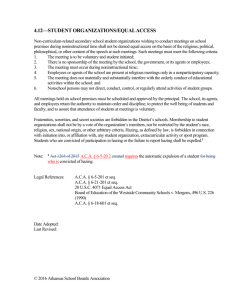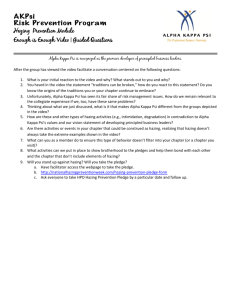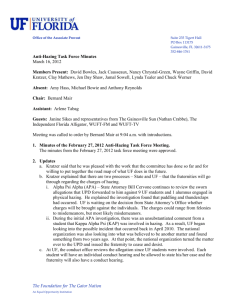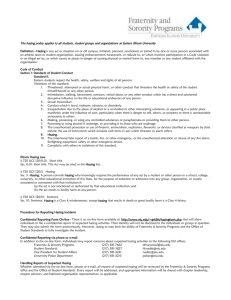Hazing - University of Virginia
advertisement
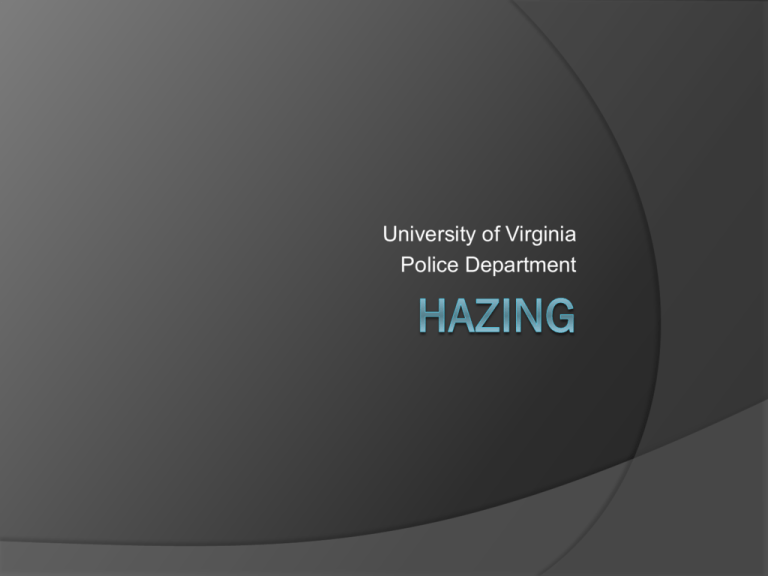
University of Virginia Police Department Hazing Defined Hazing is a broad term that encompasses an action or activity which does not contribute to the positive development of a person; • which inflicts or intends to • cause physical or mental harm or anxieties; • which may demean, degrade, or disgrace any person, regardless of location, intent or consent of participants. Any action or situation which intentionally or unintentionally endangers a student for admission into or affiliation with any student organization. Hazing is… Any activity expected of someone joining a group which humiliates, degrades, or risks emotional/physical harm History of Hazing •Hazing originated in the 16th century among sailors and crew on long ship voyages. The harassment of rookie sailors usually took place on hazy days (which could drive sailors crazy) so it became known as hazing. •Hazing emerged in Fraternities after the Civil War. Prior to the Civil war, hazing was not a major aspect in many fraternities. This is because Fraternities started out as a way for students to discuss academic life in college, something that was looked down upon in the early 19th century. However, hazing gained popularity after the civil war because many college students felt that they needed to have a harrowing event happen to them as their fathers did during the civil war. Hazing continued on after World War I. Soldiers returning from the war re-entered colleges, and brought with them the discipline and techniques they learned in boot camp •Most hazing rituals often have roots in the military, for instance; Marine recruits have often been punched, kicked and physically abused in an effort to “toughen them up” often after just getting out of bed. Myths and facts Myth #1: Hazing is primarily a problem for fraternities and sororities. Fact: Hazing is a societal problem. Hazing incidents have been frequently documented in the military, athletic teams, marching bands, religious cults, professional schools and other types of clubs and/or, organizations. Reports of hazing activities in high schools are on the rise. Myth #2: Hazing is no more than foolish pranks that sometimes go awry. Fact: Hazing is an act of power and control over others --- it is victimization. Hazing is pre-meditated and NOT accidental. Hazing is abusive, degrading and often life-threatening. Myth #3: As long as there's no malicious intent, a little hazing should be O.K. Fact: Even if there's no malicious "intent" safety may still be a factor in traditional hazing activities that are considered to be "all in good fun." For example, serious accidents have occurred during scavenger hunts and kidnapping trips. Besides, what purpose do such activities serve in promoting the growth and development of group team members? Myths and facts Myth #4: Hazing is an effective way to teach respect and develop discipline. Fact: First of all, respect must be EARNED--not taught. Victims of hazing rarely report having respect for those who have hazed them. Just like other forms of victimization, hazing breeds mistrust, apathy and alienation Myth #5: If someone agrees to participate in an activity, it can't be considered hazing. Fact: In states that have laws against hazing consent of the victim can't be used as a defense in a civil suit. This is because even if someone agrees to participate in a potentially hazardous action it may not be true consent when considering the peer pressure and desire to belong to the group. Myth #6: It's difficult to determine whether or not a certain activity is hazing--it's such a gray area sometimes. Fact: It's not difficult to decide if an activity is hazing if you use common sense. Three Main Types of Hazing Subtle Harassment Violent Subtle Hazing Any activity or attitude directed towards a pledge which embarrasses, humiliates, or ridicules. Examples ○ Silence Periods ○ Demerits ○ Scavenger hunts for meaningless objects ○ Requiring pledges to carry handbooks or paddles everywhere to get signatures ○ Calling pledge “pledgie” or other demeaning name ○ Requiring pledges to do power point presentations on the meaningless topic such as Hazing. ○ Etc. Harassment Hazing Any activity which confuses, frustrates, or causes the probationary member undue stress through mental anguish and physical discomfort. Examples ○ ○ ○ ○ ○ ○ ○ ○ Requiring ridiculous costumes or activities Requiring probationary members to perform personal services Verbal abuse Any form of questioning under pressure or in an uncomfortable position Sleep deprivation Expecting new members/rookies to be deprived of maintaining a normal schedule of bodily cleanliness. Be expected to harass others Etc. Violent Hazing Anything which causes physical or emotional harm Example ○ Forced alcohol consumption ○ Forced consumption of vile substances ○ Sexual violation ○ Assault ○ Burning ○ Forcing probationary members into life-threatening situations ○ Water intoxication ○ Public nudity ○ Abductions/kidnaps ○ Etc. The Alcohol-Hazing link •Alcohol releases inhibitions. •Underage drinking in sanctioned events. •The worst problems with hazing tend to happen when alcohol is involved. •Forcing (or the appearance of forcing) pledges to drink is a major risk because of the often unspoken peer pressure involved with drinking. In Virginia Virginia 18.2-56 Hazing is unlawful Automatically a Class 1 Misdemeanor Any victim has the right to civilly sue the person or persons guilty thereof, no exceptions. Upon proof of guilt of any student hazing another student, the college or university shall sanction and discipline such student in accordance with the institution’s policies and procedures. Organization charters shall be revoked. States without Hazing Laws Alaska Hawaii Michigan Montana New Mexico South Dakota Wyoming How to spot Hazing It's not difficult to decide if an activity is hazing if you use common sense and ask yourself the following questions: 1) Is alcohol involved? 2) Will active/current members of the group refuse to participate with the new members and do exactly what they're being asked to do? 3) Does the activity risk emotional or physical abuse? 4) Is there risk of injury or a question of safety? 5) Do you have any reservation describing the activity to your parents, to a professor or University official? 6) Would you object to the activity being photographed for the school newspaper or filmed by the local TV news crew? If the answer to any of these questions is "yes," the activity is probably hazing. How to prevent Hazing •Is this activity an educational experience? •Will this activity increase the respect for the organization? •Would you be willing to allow your parents or University officials to witness the activity? •Does the activity have value in and of itself? •If you have to ask if it is hazing… it probably is. •If in doubt, call your chapter advisor, faculty advisor, or the national office. If you won't pick up the phone, you have your answer. Hazing is "any action taken or situation created, whether on or off fraternity premises, to produce mental or physical discomfort, embarrassment, harassment, or ridicule." Brothers must not haze new members, and similarly, new members must not haze brothers!! Hazing is not the way to express to another that you will, one day, call him or her a "brother." If you allow hazing to occur you are a “hazing enabler” and no different from the person doing the hazing. Don't Fool Yourself Alternatives to Consider Foster Unity Work together on a community service project Work together to improve chapter room Work together to plan a social or sporting event Instill a sense of membership Plan events for the whole chapter to meet for a specific event Concert Movie Meals Study Session Church service… Promote the Future Take advantage of University tutoring services Designate study hours Invite speakers on test taking, study habits, etc. Use college resources for seminars on writing resumes, time management, etc. IN CONCLUSION Fitting in is a big deal, a popular way to fit in, meet lots of new people and to become involved with your school is to join a fraternal organization. But how far would you go to become part of a fraternity? Would you put up with paddling or striking, marking or branding? What if involvement included restricting of your class attendance or your sleep? What if they forced you to eat or drink or to perform calisthenics such as sit-ups, push-ups or running? How would you handle physical harassment such as pushing, cursing or shouting? How about sexual harassment? What about being berated in front of a large group? Or being asked silly or misleading questions just to be made fun of? Or being asked to participate in a food fight? Or binge drinking until you puke because you are attending a pledge event. Or not knowing when initiation is. Hazing Resources http://www.stophazing.org/index.html an extensive site covering many aspects of hazing including fraternity, sorority, athletic, high school and military hazing. http://hazing.hanknuwer.com/ Hank Nuwer is an Indiana-based author whose specialty is hazing. http://www.insidehazing.com/ to provide methods of prevention and intervention in hazing; to explain the psychology of hazing in high school, college, the military, and the workplace. Educational information is included for use in anti-hazing initiatives among fraternities, sororities, teams, and other groups.
